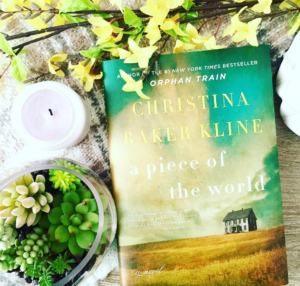- Why choose Christina Olson’s story? Out of every painting you could have researched, why did this one appeal to you?
- What do you remember about the first time you saw the painting?
- What was it that made you think there might be a novel in it?
- You mentioned being drawn to hardscrabble lives. Why?
- Why choose Christina Olson’s story? Out of every painting you could have researched, why did this one appeal to you?

Well as you probably noticed, my name is Christina for one thing and I grew up about an hour from where the story takes place in real life… My grandmother and my mother are also named Christina and my grandmother grew up pretty much at the same time period. They grew up in rural farmhouses, they both had debilitating illnesses as children, they both had no running water, no electricity, no modern amenities. So…there are a lot of resonances with me. Also I had written this novel “Orphan Train” which takes place in kind of the same time period, the early 20th century. So I had learned a lot about that time period. I wanted to stick with it and stay in that moment, so that is what I did.
- What do you remember about the first time you saw the painting?
I saw it when I was very young. We moved to Maine when I was 6 and my parents were young professors determined to show us everything the state had to offer. I just wrote an article for the New York Times about my father’s intrepid, adventurous spirit. It’s called “Trespassing in Christina’s World,” because we literally trespassed in Christina’s world. The house was not open to the public and we had a picnic down on the grass where Christina had been. I grew up knowing that painting.
Of course my name is Christina. My mother and my grandmother are also named Christina. My grandmother grew up in the same time period as Christina. There are lots of parallels. When I present on the book, I always say that by the end of the slideshow, you’ll see why I was the only person in the world who could have written this novel because there are all these connections.
It was a friend. A few years ago, after I had finished “Orphan Train,” I told her I was interested in lingering in the same time period, the early 20th Century, because I’d learned a lot about it. I’m really interested in the hardscrabble lives of people who don’t have much and the emotional tools they need to survive hard times. My friend said she had just gone to see this painting at the Museum of Modern Art, “Christina’s World,” and for some reason it had made her think of me.
Her saying that — I knew in that second I was going to write about it. It’s kind of incredible to me because I’m not sure I would have ever found the subject if it hadn’t been for that quite amazing one-off conversation with my friend.
- You mentioned being drawn to hardscrabble lives. Why?
When we moved to Maine, we lived in a normal house, but we had a camp on a lake with no electricity or running water or a bathroom or anything. At other times in my young life, we also lived in more rustic environments. My parents were kind of hippies. They came of age in the ‘60s and they were really interested in the back to the land movement. So I had a little bit of that in my own life. I also was obsessed as a child with the Laura Ingalls Wilder books and Caddie Woodlawn and the other stories for middle-grade readers that were about pioneer life.
Today, when we have the internet everywhere we go and we’ve all gotten used to living pretty securely on the grid, there’s a fascination with what it would be like to hop off. It’s not that long ago that people lived without any of it. It was much harder to live that way, especially for women, because their lives were so circumscribed. They had to spend so much time and energy on tasks that today take very little time.
